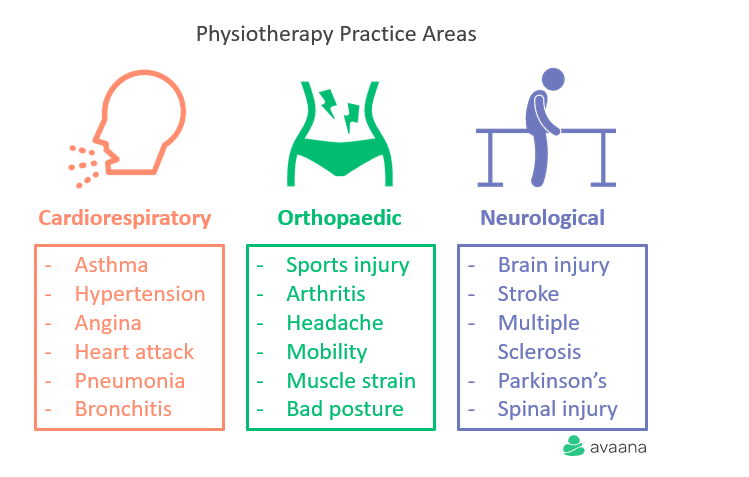Many people believe the benefits of physiotherapy are confined to sports injuries and pain management.
Technically, this assumption is correct. However, there are SO many other reasons people consult physiotherapists, e.g. Your Grandma may have limited mobility due to age. Or, your friend may need rehabilitation after surgery.
Specialised physiotherapists also help with cardiopulmonary conditions and neurological disorders.
If you want to know how this physical therapy could improve your quality of life, keep reading…
Who are physiotherapists?
Physiotherapists are experts in body mechanics. They understand the physical structure, and how anatomy and physiology helps you move.
They’re the go-to when you’re dealing with:
- musculoskeletal issues
- cardiorespiratory conditions
- orthopaedic problems
- neurological conditions.
Australian Physiotherapists are registered with the Physiotherapy Board of Australia. They can be found working in hospitals and in private practice.

Which physical therapies do they use?
Qualified physiotherapists can assess and diagnose a broad range of health conditions. Whether an injury, surgery or health condition is the cause, they can help. Their treatment toolbox includes the following hands-on, physical techniques:
- Manual therapies, like massage
- Dry needling
- Therapeutic exercises
- Joint manipulation
- Muscle stretching
- Taping (to prevent future injuries)
- Cold Therapy
- Neurodynamics
- Transcutaneous Electrical Nerve Stimulation (TENS machine)
Do physios give custom advice?
Physiotherapists treat similar problems each day. Even so, no two patients are alike. This means you’ll always receive a customised assessment and treatment approach. The basis for each session includes:
- Asses patients needs and diagnose the condition
- Work with the patient to select attainable goals
- Develop a customised treatment or prevention plan.

In Step 3, physiotherapists consider information like:
- patient’s family history
- daily activities
- type of work
- pre-existing illnesses or conditions.
The treatment plan may include exercises and the use of physical aids, as needed.
5 Common Conditions Physiotherapy Treats
Physiotherapists assist a wide range of bone, muscle, nerve and joint conditions.
Their intention is to improve muscle strength, flexibility, range of motion and endurance. Some of the most common conditions your physiotherapist could help you manage include:
1. Muscle Pain
The most common issue is muscle pains and muscle strains. These could be sports-related injuries or simply occur when body muscles are vulnerable. For example, lifting with poor posture creates vulnerability. Neck pain, back strains and shoulder discomfort are routine in a physios office. These dynamic areas of the body are vulnerable to damage. Massage, soft tissue release, motion exercises, dry needling can improve blood circulation and healing. Getting proper treatment helps decrease your risk of injury in the future.
2. Vertigo (BPPV)
Vertigo, or benign paroxysmal positional vertigo, is the sensation of spinning or swaying – even when your body is still. If you’ve ever felt dizzy looking straight down from the rooftop, this is the word for it. But, having vertigo while on the ground floor is a major cause for concern. Vestibular Physiotherapy is a specialisation that helps manage and treat vertigo. Treatment may include balance exercises, cognitive behaviour therapy, and medication.

3. Plantar Fasciitis
This is a very particular type of foot pain. Plantar Fasciitis develops when the connective tissue in your feet becomes damaged or inflamed from over-stretching. It usually involves swelling and sharp pains in your feet that worsens with movement. Effective treatment for this involves ice therapy, taping, home stretches, and specific prescriptions.
4. Tennis Elbow
Tennis Elbow is a very specific elbow injury caused by overuse of the joint. Despite the name, only 5% of the injuries are actually related to tennis. Other forms of overuse, such as lifting heavy objects or tools, are usually to blame. Physiotherapy treatment will be similar to that for general muscle pain. This could include massage, dry needling and motion exercises.
5. Arthritis
Arthritic conditions cause joint pain. There are more than 100 types, with many requiring assistive devices as the disease progresses. Physiotherapy can help reduce your symptoms and give pain relief. It may also prevent arthritis developing in the future. (You’re at risk if you’ve had physical injuries in the past). Arthritis treatment will likely involve hands-on therapy, e.g. massage, motion exercises. You may also get guidance about how to maintain or improve your fitness level in the long term.

What are the benefits of physiotherapy?
Physiotherapy is an excellent treatment option for a wide variety of musculoskeletal complaints. Here are just some of the benefits of physiotherapy you could enjoy:
1. Reduce Painkillers
Painkillers are a pharmaceutical medicine for pain relief. Some are highly addictive and have side effects, e.g. nausea, dizziness, acid reflux. It’s also possible to develop resistance over time. This is bad news, as it means you’ll need to take more to get relief. One of the benefits of physiotherapy is that it helps you reduce pain in a natural and long-lasting way.
2. Advice To Treat The Cause
Muscular spasms, stiff or locked joints, painful areas in the body. They’re all symptoms of dysfunction that can stop you living an active life. It’s always important to get medical advice in these situations. Fortunately, physio can help you treat the root cause of your problem.
3. Avoid Surgery
One of the biggest benefits of physio is that it helps some people avoid surgery. It’s always best to leave surgery as a last resort. Try everything else first, as you may find amazing benefits where you least expect them. Therapeutic techniques, like exercise and massage, help many people manage and reduce pain. They’re also excellent when you’re in recovery from injury. Physios regularly prescribe foam roller stretches for rehabilitation.
4. Pain Management
Chronic pain doesn’t always have a treatable (or identifiable) cause. If you’re in pain and have reduced mobility, you probably feel frustrated – which is normal. Using physio as an approach to therapy can benefit your physical and mental health. Proper treatment may help you reduce pain and create strategies to decrease it. Some patients even learn how to predict the onset of pain and can do the exercises that delay or stop it.
5. Injury Prevention
When a part of your skeletal system is weak, it doesn’t function as well as you’d expect. The resulting strain on surrounding joints causes damage and pain. This can become severe over time, resulting in fractures, sprains and severe spasms. Expert physiotherapists can help you identify weakness in your frame, and ways to improve it.
How fast does physiotherapy work?
While physiotherapy can work wonders, it is not a miracle cure and results are not instant. It may take as long as 8-12 weeks to see full results. This timeframe is dependant on how regularly you visit your physio. And how committed you are to doing your exercises, if they’ve been prescribed. Consistency is most important during the first few weeks of treatment. For best results, see your physio several times a week in the beginning, if possible.
What are the side effects of physiotherapy?
Regular physiotherapy sessions have heaps of benefits. However, in the short-term, your experience may feel a little uncomfortable. You may get exhausted or have sore muscles afterwards. These side effects are only short-lived and part of mobility training. You can always spread out your sessions if needed to allow more time for recovery.
Ready to see your local physio?
If you’re in pain or recovering from an injury, it’s time to visit your local physiotherapist. They’ll be able to tell you what your healing timeline looks like, and what to expect.
If you’re looking for a physio near you, Avaana can help. Use Avaana to book your appointment and you’ll enjoy 20% offyour first treatment.




